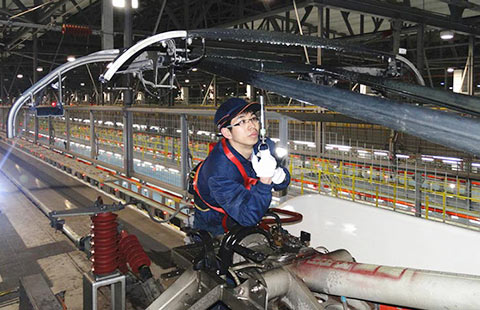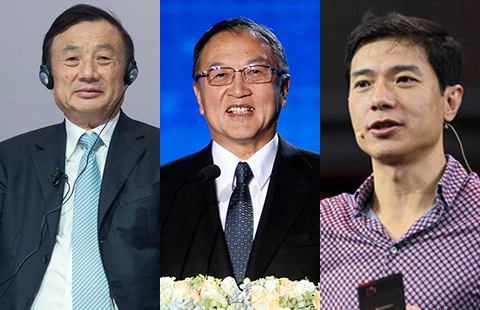China still a top destination for foreign companies
(China Daily) Updated: 2012-09-05 03:20New trend
The International Monetary Fund predicted that, based on the current trend, China will overtake the US to become the largest economy by 2017.
In its 12th Five-Year Plan (2011-15), China has vowed to shift to grow domestic consumption from largely relying on overseas shipments, and is committed to promoting urbanization.
President Hu Jintao said China’s social retail consumption is expected to grow annually by 15 percent during the 2011-15 period, reaching 32 trillion yuan in 2015. From 2011 to 2015, China’s imports would surpass $8 trillion.
"Consumption-related sectors will be hot, and sectors that go well with China’s new direction of economic growth, including high-tech, services and new energy, will also see more foreign investment," said Wang.
In December, China launched a new version of its Foreign Direct Investment Industry Guidelines, in which the government encourages foreign investors to put money into advanced manufacturing, the service sector, research and development, and in energy-saving and strategic emerging industries.
In its 12th Five-Year FDI Guidelines, China said it is focusing on the "quality" of foreign investment.
"Given that three decades of high growth has resulted in severe environmental pollution and a huge waste of resources. China should be selective," Wang said.
As an innovative industrial group and also a leader in high-tech development and solutions, US-based Minnesota Mining and Manufacturing Co (3M) is cashing in on new business opportunities in China amid the transformation.
In June, 3M revealed a five-year, $50 million investment plan for China, a major part of its five-year strategy to increase annual sales in the emerging market by between 15 and 20 percent, according to Hu Fen, vice-president of 3M China Operations and Finance.
3M’s China business accounts for 10 percent of its global operations.
The nation’s efforts to grow consumption are proving very enticing for some companies. Sweden-based Ikea, which has so far displayed a prudent approach toward its development in China, said it would now experience a rapid expansion in the country, opening two to three stores annually.
The company plans to open its second store in Beijing in the suburbs of the city, the largest Ikea flagship store in Asia and the second-largest in the world.
And as the nation actively encourages the development of its central and western regions to stimulate the economy, many foreign companies are well on track to grow in the region, represented by Samsung, which announced its largest overseas investment in Xi’an, Shaanxi province, also the largest ever in western China.
3M is building a plant with an investment of $200 million in Hefei, Anhui province, which will be engaged in production for Central China’s new energy, automotive and shipbuilding industries.
For foreign companies, investment translates into commercial benefits for both sides.
"The deals will help stimulate the culture and tourism industries in China, and they are also a good reflection of enhanced China-US economic and trade ties," said Zhang Zhizhong, executive vice-president of The Walt Disney Co.
The US entertainment company announced it will create a $3.7 billion theme park in Shanghai, which is scheduled to open in 2015.
Ted Dean, chairman of the American Chamber of Commerce in China, agreed.
"When a US firm expands in China, it brings capital, training, business practices, and technology that benefit China, and the company benefits from the new opportunities it’s able to tap," said Dean.
Worries unnecessary
Dean attributed China's FDI decline to the global economic situation, saying worries are unnecessary. "The global economy affected Chinese FDI," said Dean.
And "surveys by AmCham China showed US companies are committed to the Chinese market, and big companies are already here in China, so there are not necessarily new FDI numbers," he said.
The US is a major investor in China. During the past seven months, China's FDI from the nation gained by 1 percent to $1.96 billion, while FDI from the EU dropped by 2.7 percent.
To help the economy rebound, some local governments, including Tianjin and Chongqing municipalities, and Changsha in Hunan province, have announced plans to boost industrial investment over the past few months.
China cut interest rates in June for the first time in three years, and again in July. The nation's central bank has also lowered the reserve requirement ratio for lenders three times starting in November to support growth.
"We are encouraged by the actions ... and we expect China will continue to ease policy and increase investment spending to help improve growth. Those actions will likely lead to better growth in the construction industry late in 2012 and into 2013," said Thieneman from Caterpillar.
Despite the preferential policies adopted by many countries worldwide, China remains an attractive market for foreign companies, due to the struggling economy in developed markets and the unfavorable business climate in many developing economies.
Doug Oberhelman, chief executive officer of Caterpillar, said in August that the global economic outlook is more uncertain now than at the start of the financial crisis in late 2008.
"It would take another five years before Europe’s economy begins to see growth again," he said.
Contact the writers at dingqingfen@chinadaily.com.cn and liujie@chinadaily.com.cn
- Alibaba needs to think big on world stage
- Jack Ma eyes acquisitions to weave his magic again
- PBOC injects yet more pre-holiday money into market
- China stops approving new coal mines
- Chinese tourists expected to become most powerful buyers in winter season
- China tops world in PV installation capacity
- Chinese Premier vows to deepen reforms
- China retains as Malaysia's largest trading partner in 2015
















